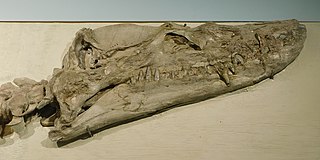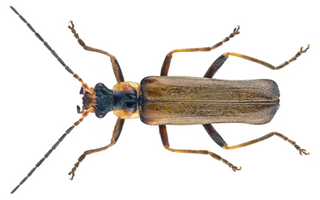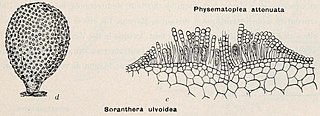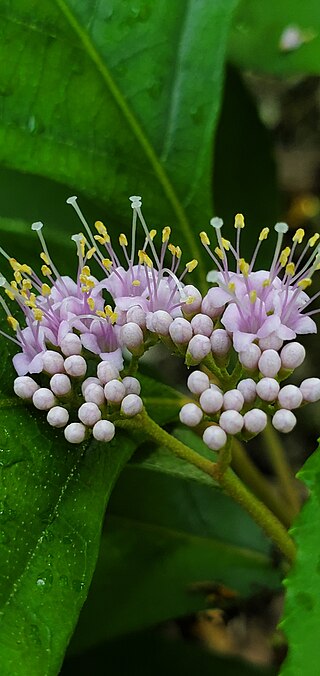
Alice Eastwood was a Canadian American botanist. She is credited with building the botanical collection at the California Academy of Sciences in San Francisco. She published over 310 scientific articles and authored 395 land plant species names, the fourth-highest number of such names authored by any female scientist. There are seventeen currently recognized species named for her, as well as the genera Eastwoodia and Aliciella.

Gymnopilus junonius is a type of mushroom-forming fungus in the family Hymenogastraceae. Commonly known as the spectacular rustgill, this large orange mushroom is typically found growing on tree stumps, logs, or tree bases. Some subspecies of this mushroom contain the neurotoxic oligoisoprenoid gymnopilin.

Dipteryx charapilla is a little-known species of flowering plant in the family Fabaceae, a large to mid-sized tree growing along rivers in the rainforests of Brazil. and Peru.
Craugastor rugosus is a species of rain frog in the family Craugastoridae. It is found in Costa Rica and southwestern Panama, and possibly southern Nicaragua.

Dudleya stolonifera is a succulent plant known by the common name Laguna Beach liveforever or Laguna Beach dudleya. This is a rare plant which is endemic to the coastline of Orange County, California. It is known from only about six populations in the vicinity of Laguna Beach, totaling about 30,000 individuals. It is federally listed as a threatened species of the United States.

Styxosaurus is a genus of plesiosaur of the family Elasmosauridae. Styxosaurus lived during the Campanian age of the Cretaceous period. Two species are known: S. snowii and S. browni.

Simolestes is an extinct pliosaurid genus that lived in the Middle to Late Jurassic. The type specimen, BMNH R. 3319 is an almost complete but crushed skeleton diagnostic to Simolestes vorax, dating back to the Callovian of the Oxford Clay formation, England. The genus is also known from the Callovian and Bajocian of France (S.keileni), and the Tithonian of India (S.indicus). The referral of these two species to Simolestes is dubious, however.

Van Sung's shrew, also known as Cao Van Sung mountain shrew is a species of shrew in the Soricomorpha order. Specimens of Chodsigoa caovansunga have been found in Vietnam.
Aetheliparis rossi is a species of snailfish only known from the mesopelagic zone in the North Atlantic off Cape Hatteras, North Carolina. This species is found at depths of from 500 to 674 metres.
Dendrelaphis oliveri, commonly known as Oliver's bronzeback, is a species of nonvenomous arboreal snake in the family Colubridae. The species is endemic to Sri Lanka. It is considered to be the rarest of the Sri Lankan Dendrelaphis species on account of there being only a single recorded specimen.
Paul Georg Egmont Duncker was a German ichthyologist.

Digitalis davisiana is a species of foxglove, a herbaceous plant in the genus Digitalis in the family Plantaginaceae, formerly in the Scrophulariaceae and briefly the Veronicaceae. It is native to Turkey.

Podabrus alpinus is a species of soldier beetles native to Europe.

Soranthera ulvoidea, sometimes called the studded sea balloon, is a species of brown algae in the family Chordariaceae. It is the only species in the monotypic genus Soranthera. The generic name Soranthera is from the Greek soros (heap) and antheros (blooming). The specific epithet ulvoidea refers to certain resemblances the algae has with Ulva. The name in Japanese is 千島袋のり / ちしまふろくのり literally meaning "Kuril Islands bag nori".

Podabrus pruinosus, the downy leather-winged beetle, is a species of soldier beetle in the family Cantharidae. It is found in North America.
Butia arenicola is a very small species of Butia palm with an underground trunk; native to Paraguay and the state of Mato Grosso do Sul in Brazil. Boquierinho is recorded as a possible local vernacular name for it.

John Krider was an American gunsmith and ornithologist who operated a sporting goods store on the northeast corner of Second St. and Walnut St. in Philadelphia, Pennsylvania, for much of the 19th century. On the second floor of Krider's shop was a taxidermy shop, where hundreds of bird specimens were prepared over multiple decades.

Eumicrotremus spinosus, commonly known as the Atlantic spiny lumpsucker, is a species of lumpfish native to the Arctic and North Atlantic.

Callicarpa lamii is a plant in the mint family that is endemic to the Mariana Islands. It is one of two Callicarpa plants endemic to the Mariana Islands, the other being Callicarpa candicans var. paucinervia.













